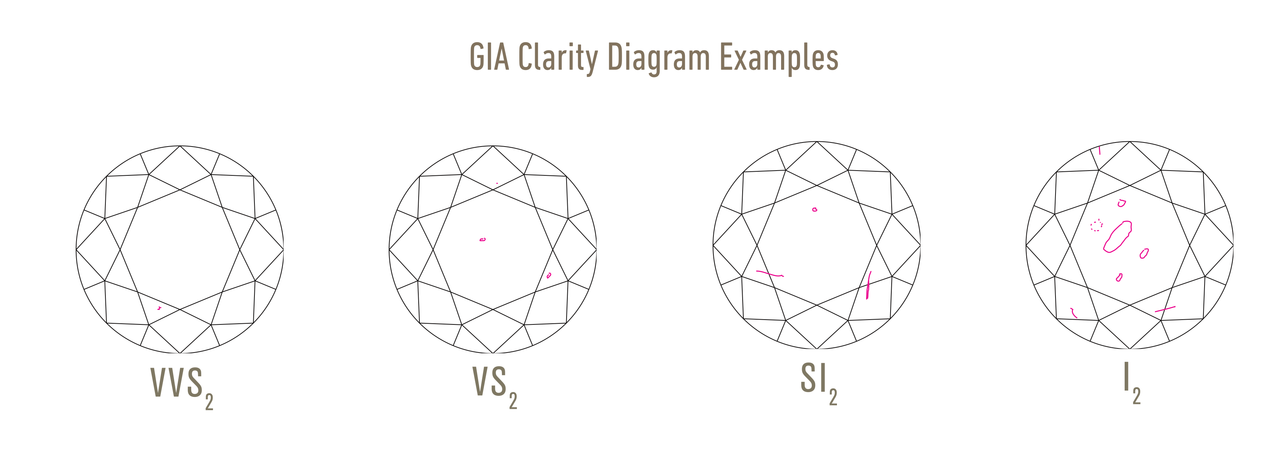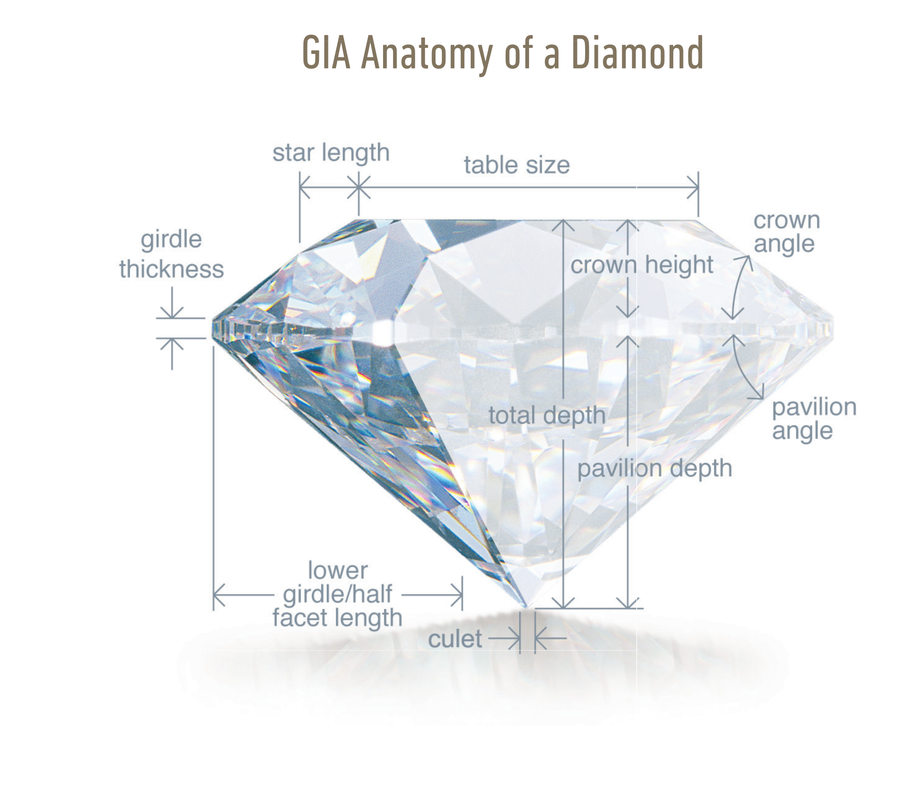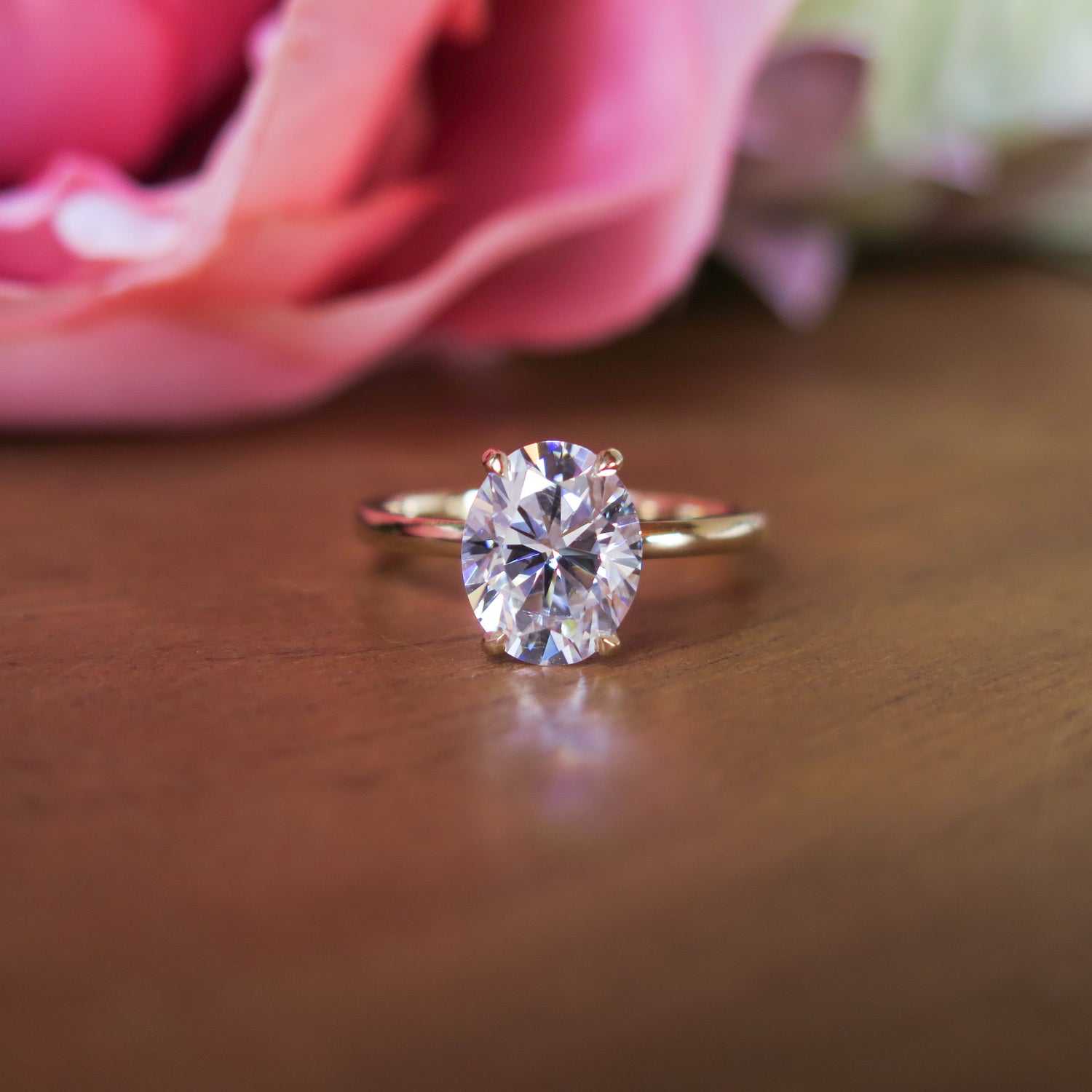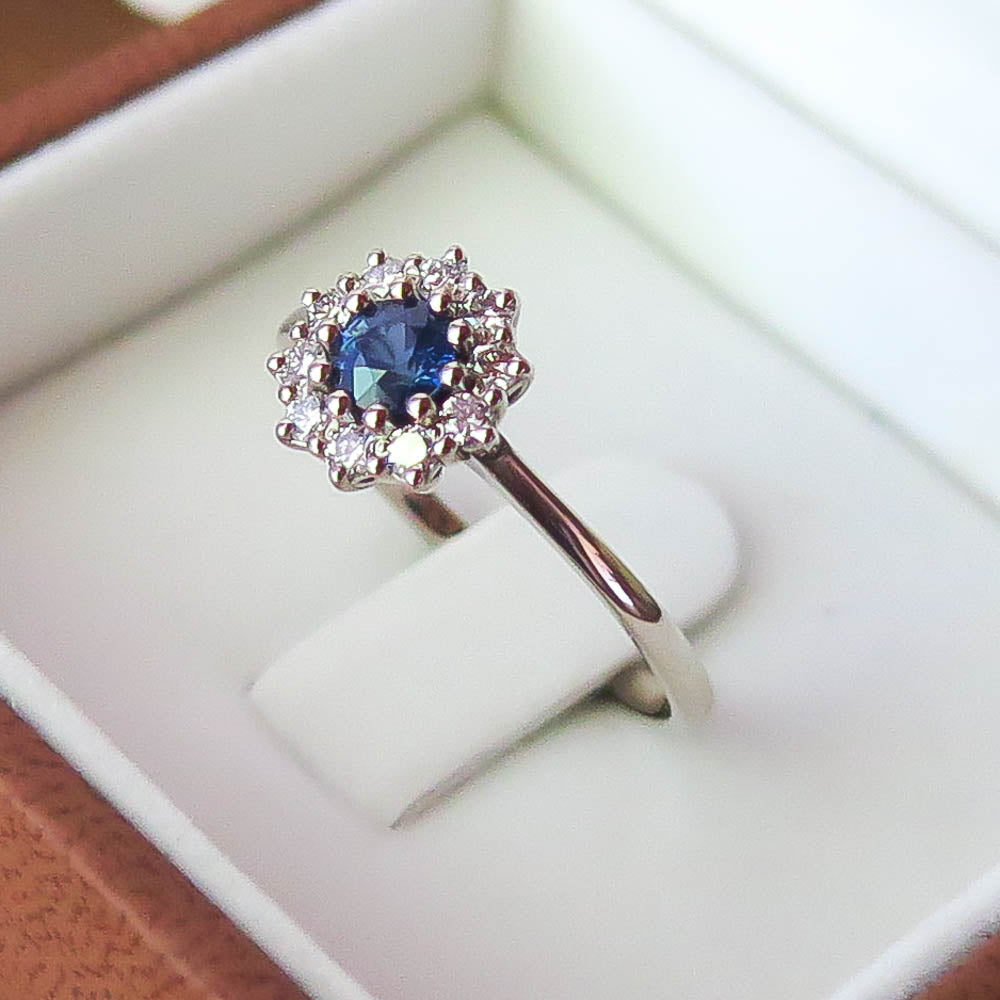Diamonds
All of our diamonds are sourced from reputable Southern African and international labs adhering to the Kimberley Process, the Gemological Institute of America (GIA) being our preferred laboratory. All stones larger than 0.50 ct are accompanied by a lab certificate stating the measurements, weight, colour and clarity grade of the stone as determined by the laboratory. Lab certification on stones below 0.50 ct. is available on request.
What if I already have a diamond?
No problem. Weddings are expensive and we all try to save wherever we can. If you already have a diamond, be it a family heirloom or a diamond bought through another connection, you are most welcome to bring it along. You will not be judged.
What should I look out for when buying a diamond?
The four most important factors in gemstone grading are the four C's; Cut, Colour, Clarity, Carat.
Below is a breakdown of each factor in descending order of impact on price:
Carat
Carat (abbreviated ct.) refers to the actual weight of the stone measured in carat. One carat is equal to 0.20 gram and is determined with a special, very sensitive scale. In the lab the weight is determined to the third or sometimes fourth decimal, a measurement not easily obtained with the equipment commonly found in the average jewellery studio.
Colour

The second most important factor influencing the price of a diamond is the colour grade of the stone. Colour grading according to the GIA's internationally accepted grading system starts at D, which is colourless, and continues down the alphabet, growing increasingly yellow as it does. The differences from one grade to the next are so minute that they are determined by comparing the stone to a master-set in the lab under very specific lighting conditions. The value of the stone drops as the yellow component increases until it reaches a distinctly yellow hue, which is when the value starts rising again. A yellow stone with a strong hue can be several times more expensive than a colourless stone of the same size and clarity.
When we think of diamonds we normally think of white stones, but diamonds are actually available in a variety of different colours. The most common is yellow, but they also occur naturally in black, charcoal, cognac, blue, green, pink and most rarely in red. Naturally coloured diamonds of a bright, deep hue and even saturation with a brilliant sparkle are insanely expensive, much more so than white diamonds, and are not easily sourced, but they can be found if you know where to look.
It is also possible to colour diamonds artificially through a process called irradiation, but these stones, though usually of a very deep, intense colour, are normally a little milky or heavily included. Labs don't like wasting good grade stones on artificial treatments. Much of the black diamonds available on the market are the result of irradiation, so make sure you know where it was mined if your aim is to purchase a naturally coloured stone.
Clarity

Clarity refers to how many tiny cracks or bits of coal your stone has on the inside. The GIA grading system breaks it down as follows:
F - Flawless: a diamond which has no cracks, marks or inclusions either inside or on the surface of the facets at 40 x magnification in the lab. These are extremely rare and very pricey.
IF - Internally Flawless: a diamond which has no cracks, marks or any inclusions on the inside at 40 x magnification, though naturals or extra facets are present on the outside. Also very rare, also very pricey.
VVS 1 & 2 - Very, Very Small Inclusion (with two subgrades, 1 & 2): a diamond which shows tiny cracks, marks or inclusions at 40 x magnification, but which are not visible to the naked eye.
VS 1 & 2 - Very Small Inclusion (also with two subgrades, 1 & 2): a diamond which shows cracks, marks or inclusions at 40 x magnification, which are visible at 10 x magnification to the trained eye, and not visible to the naked eye.
SI 1, 2 & 3 - Small Inclusion (with three subgrades, 1, 2 & 3): a diamond which shows cracks, marks or inclusions at 10 x magnification and is visible to the trained naked eye or the very astute untrained observer, but which does not detract from the brilliance of the stone.
I 1, 2 & 3 - Included (three subgrades): a diamond which shows cracks, marks or inclusions which are visible even to the untrained naked eye, and which detracts from the brilliance of the stone.

Cut
In most commercial stones, the cut does not affect the price as much as it does on collector's pieces. Cut refers not only to the shape but also to the quality of the lapidary work. Extra facets and skewed proportions generally detract from the brilliance of the stone, but won't make much of a difference on stones below 1.0 ct. Round stones are generally more expensive than other shapes, but a poorly cut round stone will probably sell at a lower price than a well cut stone of a different shape. For commercial jewellery purposes, most stones on the market fall within an acceptable range of cut quality, even those above 1.0 ct, and therefore this does not affect the price much, nor is it something we advise our clients to be concerned about when selecting a diamond. Occasionally a diamond which is too deep or too shallow crosses our desks, but it doesn't happen often and it is usually clearly visible right away. Ultimately, unless you are buying diamonds as an investment, choosing the one you find most beautiful is the best rule of thumb.
Ideal Proportions
The GIA does prescribe an ideal proportion for round stones, at which all the light that enters the stone through the table is reflected back out through the table, resulting in optimal brilliance. Your diamond's proportions are indicated in the certificate for easy comparison.

A diamond with ideal proportions has a crown with a height of 19.2% of the diameter, a pavilion depth of 40%, a table diameter of 56.1% of the diameter of the stone, a crown angle of 41.1°, a pavilion angle of 38.7°, and a girdle thickness ranging between 1.25% and 1.75% of the diameter. A lapidary will normally choose to optimize weight retention rather than obtaining a better cut, since that has a bigger effect on price, so these measurements are not a rigid standard but are deemed acceptable if they fall somewhere near the ideal proportions. A stone which is cut too deep will appear darker and seem too small for its weight, and a stone which is cut too shallow will often lose sparkle or appear too large for its weight.

Are you thinking of getting engaged soon?
Book a free consultation (in person or via Zoom) and let me help you bring your idea to life. Free nationwide door-to-door shipping is included on all orders over R1500.

Frequently Asked Questions
How does it work? Where do I start?
The best place to start is with the gemstone that will be the central feature of the ring because this dictates many of the other proportions of the piece. For a detailed breakdown of the process, click here.
Can I bring my own diamond or other gemstones?
Yes, you are more than welcome to do that. Many people inherit a stone from a family member or would like to reuse a stone they bought on another occasion. That is perfectly fine with me.
What metals do you work in?
I work in all precious metals commonly used for jewellery, so that would be sterling silver, argentium silver, yellow gold and white gold (9K, 14K, 18K), and platinum. For more information on precious metals and the difference between them, click here.
What is the difference between white gold and platinum?
Platinum is an element on the periodic table, a metal in its own right, while white gold is an alloy of pure yellow gold and other metals. Here is a bit of history:
In the late 19th century bench jewellery was revolutionised by the invention of the
pressurised oxygen tank, or liquid oxygen, which for the first time became
commercially available at affordable prices. This led to the development of the
oxyacetylene mixing torch, invented in France by Edmond Fouché and Charles
Picard, and for the first time made possible a flame that could reach the
temperatures required for solid platinum (Pt) jewellery manufacturing.
Platinum quickly emerged as the new darling in the world of fine jewellery, with its
brilliant white colour it complimented white diamonds, which thanks to De Beers
were having a moment at the same time too, and its fantastic tensile strength
made extremely delicate designs possible for the first time in history.
With the end of the Edwardian era and the start of WWI, platinum all but disappeared in
jewellery, due to its usefulness as a catalyst in explosive devices but
experienced a brief period of resurging glory (the Art Deco period) between the
great wars, mostly thanks to the discovery of the Merensky Reef, a platinum
deposit which stretches from northern Gauteng into Mpumalanga and Limpopo.
During WWII the US government declared platinum a metal of strategic importance, and almost
completely banned its use in anything outside of military applications. This
led to the development of a new gold alloy we know today as white gold.
White gold is a mixture of pure yellow gold and other metals such as silver, copper and
zinc, which are common in other gold alloys, but with the addition of palladium
or nickel to bleach out the yellow colour. Because its base is still yellow
metal, it isn’t quite white and is usually plated with another, whiter metal to
create the crisp white finish consumers expect. This used to be done with
rhodium (Rh), but after that metal’s price skyrocketed in recent years, it has
been replaced by other metals.
Nickel alloys have almost completely fallen out of use because most people are
allergic to them. It perseveres in mass production white gold jewellery though,
so be sure to ask before you make a purchase. My preferred alloy contains 10%
palladium. Although the palladium content makes it quite a bit more expensive
than the nickel alloys, it has good tensile strength, is unlikely to cause
allergic reactions, and has a white enough finish for it to still appear white
even without the plating.
Because it contains gold (Au), white gold alloy fineness (purity) is expressed the same
way as yellow gold, in karatage (9K, 14K, 18K) or parts in 1000 (375, 585, 750). In South Africa platinum jewellery is usually 95% pure Pt, with a 5%
copper or ruthenium alloy.
You can read more about the composition of white gold here.
Can I buy a diamond from you?
Yes, I source quality diamonds based on your requirements. During your consultation we can discuss the pros and cons of both natural and laboratory-grown diamonds. I usually call a few options for you to view before making your decision. I do not keep diamonds on the premises for security reasons, so you will need to book this viewing in advance. For more information on how to choose a natural diamond, click here. For more information on laboratory-grown diamonds, click here.
What if I don't want a diamond?
I get you. There are plenty of other options. Moissanite is increasingly popular as a replacement for diamond, and lots of people are opting for coloured gemstones instead. I can source whatever you need. Click here to browse a selection of coloured gemstones I offer on behalf of a third party seller. Like with diamonds you will need to book viewings in advance because I need time to request the stone from the supplier.
What is moissanite?
Moissanite is a man-made gem which has very similar properties to diamond, although not quite as hard. Click here to read more about this affordable alternative.
What other services do you offer?
Other services include remodeling of old jewellery and insurance valuations. For a list of my services, click here.
Can I see some of the things you have made?
My social media accounts are really the best place to see this, but I have a small gallery on the website which you can find here.
